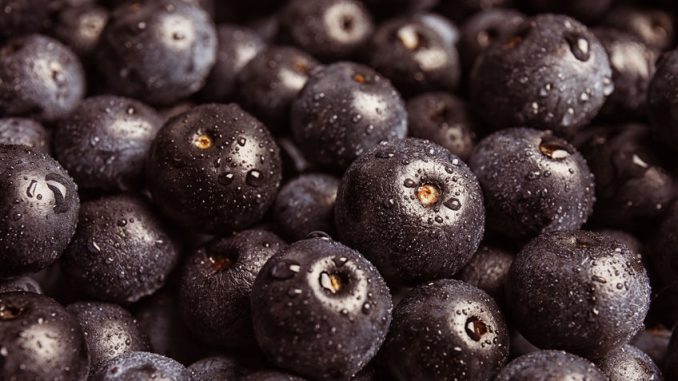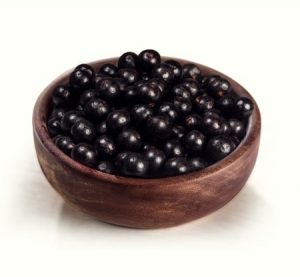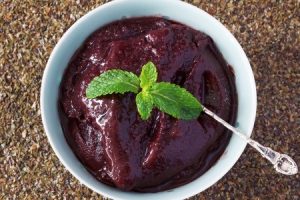
The Acai berry (Euterpe oleraceae Martius.) is one of many new ‘superfruits’ finding favour with product developers looking to exploit its novel properties. It is also known as the Amazonian Palmberry, Assai, pinot, wassai, manicole and Pina and is a large palm tree.

The trees are found in tropical parts of Brazil, Guyana and Suriname and are now cultivated.
The all natural energy berry has been used by Indian tribes native to the Brazilian Amazon for centuries as it provided them with:
- ‘strength’;
- acted as a natural stimulant;
- had unparalleled nutritional content.
Description Of Acai Fruit
Its spherical grape-sized fruits are green when young and ripen usually to a dark purple (Strudwick & Sobel, 1988). Its fruit is harvested when it turns purple. The edible portion corresponds to only 7% of the fruit weight. In order to make it easier to obtain the pulp, water is added while de-pulping the fruit. According to the amount of water added during this process, it produces Açaí Grosso which means thick açaí containing >14% of total solids, Açaí Médio (medium açaí) containing between >10% and 6.14% of total solids and the Açaí Popular (popular açaí or thin açaí) containing 6.10% of total solids. The pH is between 5.3 and 5.6. The pulp is dried to contain about 40% fat.
The fruit has been linked positively in a number of studies to reducing many disease states. One such benefit is its anti-inflammatory properties whereby it may offer protection by maintaining the flexibility and tenor of arteries, so making them less prone to atherosclerosis (Xie et al., 2011). The research was supported by MonaVie LLV which produces and distributes acai juice. The juice is claimed to inhibit the formation of cytokines which are inflammation factors, by regulating the role of mediators in their production.
The Nutritional Benefits Of Acai
Information available on Acai states the fruit is a “powerhouse of nutrition” and provides the “best nutritional value compared to any fruit on earth”. Information sources from manufacturers websites such as www.sambazon.com to independent news sources such as New Nutrition Business and blogs have a positive reaction to the “Super Fruit”.

- Natural energy source
The Brazilians have used Acai as a natural stimulant for centuries and Brazilian athletes concocted formulas of acai, guarana and cane sugar to develop energy drinks. In energy drinks released in Europe and the US, Acai has been paired with Guarana, the Brazilian natural energy (caffeine) stimulant.
- Highest antioxidant levels in fruit
The ORAC (measure of its antioxidant properties) is higher than any other edible berry on the planet. Acai contains 10 times the antioxidant levels of grapes and 33 times the anthocyanins (purple antioxidants) of red wine. (Lichtenthäler et al., 2005; da Silveira et al., 2019). Thus, it is claimed to combat premature aging. The flavonoids within the fruit have been attributed with these nutritional properties (Kang et al., 2010).
- High in essential fatty acids and omegas
Acai contains omega 6 and omega 9 essential fatty acids: beneficial or “good” fats that help maintain healthy cholesterol levels and regulate inflammation.
- Source of dietary fibre
Fibre is tipped to be the next big thing in terms of the health trend in 2006 / 2007. Acai is an excellent source of dietary fibre.
- Source of Protein
Acai contains more protein than an average egg apparently! This isn’t hearsay as there is evidence from in-house protein measurements at FoodWrite Ltd unfortunately it is confidential.
- Contains many Phytosterols
Acai contains many phytosterols which reduce blood plasma cholesterol. The phytosterol, beta-sitosterol may help prevent immune weakness resulting from severe physical stress. It is also claimed Acai fights infection, protects the heart and can control prostate enlargement. It also contains a novel flavone known as velutin which has been discussed previously.
- Contains essential amino acids
Almost perfect essential amino acid complex in conjunction with valuable trace minerals. Vital to proper muscle contraction and regeneration.
- High number of Vitamins and Minerals
Minerals include Iron, calcium, copper, zinc, potassium, phosphorous and magnesium
Vitamins include B1, B2, B3, C and E and according to some sources A,D and K in addition.
Other facts on acai:
- High-calorie fruit
High calorie content due to high lipid content – twice the amount of calories as milk.
Need to check calorie content in relation to other fruits.
Comments About Acai in the public domain
“The juice of the Acai berry may represent one of the most exciting product opportunities in the young history of the functional foods business.” (New Nutrition)
“It’s already developing a cool, cult-like following behind it in the US. And it’s sexy and comes out of Brazil, which is hot” (Zola Acai)
“Acai pulp contains an impressive and perhaps unequalled nutritional elixir” (New Nutrition)
“It’s really delicious, one of our newest flavours and we think it has phenomenal potential… a lot of health-conscious consumers have been reading about Acai” (Naked Juice)
Taste
Despite the growing health consciousness among consumers, taste remains the number one factor in influencing purchase decision according to Mintel.
Acai has a unique taste described as a blend of chocolate and berries. It has a mature and complex flavour that has proved successful among those trying it. The drink appears in various Acai Juice Bars throughout Brazil which indicates the product provides sensory benefits in addition to functional benefits.
It has a bitter aftertaste which may make it popular for sports players after exercise as they tend to prefer sour rather than sweet tasting drinks according to athletes.
Consumer Insight
A report called “The Evolution of Global Consumer Trends” from Datamonitor highlighted in 2008 a number of interesting consumer insights on this fruit.
Authenticity & Experiences
“Consumers are seeking exotic flavours and new cultural experiences from their food and drink consumption” according to Datamonitor. In addition they are seeking authenticity in their experiences and thus are placing a high value on provenance.
Acai “combines the fruits’ unparalleled nutritional attributes with the romance of the Amazon rainforest” (New Nutrition Business). The country of origin, Brazil, fits with consumers’ desire for more exotic cultural experiences. In the UK, a trend towards Brazilian food and drink is emerging especially in the drinks market.
Health & Trust In Acai Fruit
Consumers have become more aware of the link between diet and health, according to research by Datamonitor. The health movement in Western culture has shifted from the desire to look better to the need to promote overall health. The recent trend in diets seems to support this and suggest that consumers are becoming more sceptical of “fad” diets such as low carb and are seeking to access a range of “unbiased” sources to create “customized” natural diets focused on holistic health.
Acai is a natural ingredient with a wide range of balanced functional benefits. Coverage of Acai in public domains and blogs is very positive. This encourages trial as modern consumers are moving away from trusting official sources and promotions to trusting consumer recommendations. Consumer awareness of Acai among health conscious consumers is fairly low but seems to be growing. Acai is also receiving positive endorsements from diet experts and being labelled as a “super fruit” in terms of its nutritional content.
The Acai Berry And Managing The Amazon Rainforest.
There is increasing importance placed on preserving the environment and “doing the right thing”. Honesty and integrity are now key desirables for consumers as ethical values create positive emotions for the consumer.
It is claimed that producing Acai will help “sustainable” agriculture in the rainforest. The more Amazonians could be encouraged to tend crops of wild Acai, the less likely they would be to strip the trees from the forest to convert the land to arable plots.
Coolness
Modern consumers are more image conscious than previously and desire products that are seen as “cool” according to a Datamonitor consumer survey.
Acai has developed a cool, cult-like following in the US due to its exotic provenance, exclusive nature, ethical benefits and unique flavour. There are a number of entrepreneurs who are promoting the ingredient below the line to raise familiarity and promote desire among consumers. The name of the ingredient is pronounced in a similar way to the popular Japanese beer Asahi which could add to the ingredient’s appeal.
Popular Combinations For Acai Berry in Brazil
- Acai pulp, guarana and organic cane sugar creates a chocolate-berry flavour: a concoction that was supposedly enjoyed by Amazon warriors.
- Amazonian speciality: comes mixed with crushed ice to make a sorbet, then topped with granola and sliced bananas
Processing Acai Fruit
Conventional fruit processing methods are certainly adopted – the use of thermal processing methods for most soft fruit drinks equally work well for this berry. However, given the significant health benefits of the fruit, non-thermal processing is a must.
To this end, High Pressure Processing (HPP) has been successfully tried. Optimum processing conditions of 400 MPa for 3 minutes appears to deliver a log5 reduction in pathogenic organisms such as E. coli O157, Listeria monocytogenes and Salmonella spp (Gouvea et al., 2020). The general issue is that Salmonella is a more resistant group of species to processing. It becomes increasingly more difficult to achieve the necessary log kill reduction as the pH and the total solids rises in the juice. Pulpy juices would be the most difficult to process and would demand higher processing pressures – say 600 MPa at 3 minutes if not longer.
References
da Silveira, T. F. F., Cristianini, M., Kuhnle, G. G., Ribeiro, A. B., Teixeira Filho, J., & Godoy, H. T. (2019). Anthocyanins, non-anthocyanin phenolics, tocopherols and antioxidant capacity of açaí juice (Euterpe oleracea) as affected by high pressure processing and thermal pasteurization. Innovative Food Science & Emerging Technologies, 55, pp. 88-96 (Article)
da Silveira, T. F. F., & Godoy, H. T. (2019). Non-Anthocyanin Phenolic Compounds in Açaí (Euterpe oleracea Mart.) Juice by Ultrahigh-Performance Liquid Chromatography-Diode Array Detector (UHPLC-DAD): A Multivariate Optimization. Journal of Chromatographic Science, 57(2), pp. 139-148 (Article)
Gouvea, F., Padilla-Zakour, O., Worobo, R., Xavier, B., Rosenthal, A. (2020) Use High-Pressure Processing To Ensure Safety of Acai Juice (Euterpe oleracea Mart.) SHIFT2020 Poster
Kang, J., Li, Z., Wu, T., Jensen, G. S., Schauss, A. G., & Wu, X. (2010). Anti-oxidant capacities of flavonoid compounds isolated from açaí pulp (Euterpe oleracea Mart.). Food Chem., 122, pp. 610–617.
Lichtenthäler, R., Rodrigues, R. B., Maia, J. G. S., Papagiannopoulos, M., Fabricius, H., & Marx, F. (2005). Total oxidant scavenging capacities of Euterpe oleracea Mart. (açaí) fruits. Int. J. Food Sciences and Nutrition 56, pp. 53–64.
Strudwick, J., & Sobel, G. L. (1988). Uses of Euterpe oleracea Mart. in the Amazon estuary, Brazil. Adv. Economic Botany, 6, pp. 225–253.
Leave a Reply